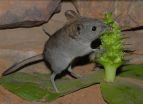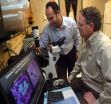(Press-News.org) Long-nosed Cape rock elephant-shrews are fond of sticky treats, according to Dr. Petra Wester from the University of Stellenbosch in South Africa. Her investigations show for the first time that the elephant-shrew, Elephantulus edwardii, licks the nectar of the flowers and pollinates the Pagoda lily. Her results are published in Springer's journal, Naturwissenschaften – The Science of Nature.
Dr. Wester studied the behavior of the animals in the northern Cederberg area of South Africa, where Pagoda lily plants, Whiteheadia bifolia (Hyacinthaceae), are found in shady rock crevices and cavities. Over four nights, she placed mammal traps with baits – a mixture of peanut butter and rolled oats – near the lily plants. The next day, Dr. Wester collected the faeces of the animals from the traps. Two elephant-shrews were captured and released into glass terraria containing flowering lily plants, where Dr. Wester observed their foraging behavior.
The captive elephant-shrews visited the flowers more than 50 times over four days, moving from one flower cluster to another. With their long, flexible noses they went between the stamens and licked the nectar between the ovary and the stamens with their long, slender tongues. In the process, they touched the pollen-sacs and their long nose got dusted with pollen. The animals also touched the stigmas.
The elephant-shrews indulged in the nectar without feeding on pollen directly or eating, damaging or destroying the flowers. Interestingly, the animals preferred the nectar over the other food – peanut butter with rolled oats and apples – and over water. Dr. Wester also found that the faecal samples of the elephant-shrews contained pollen from the Pagoda lily, the likely result of fur grooming after flower visits, rather than actual feeding on pollen.
Elephant-shrews, together with rodents, primates and marsupials, are part of a rather unusual group of pollinating animals that are known as 'non-flying mammals' to differentiate them from the more common bats. Elephant-shrews look similar to mice, except for their long nose, but are not related to rodents. They belong to the order Macroscelidea, which includes aardvarks, tenrecs, golden moles, hyracoids, sirenians and elephants.
Dr. Wester concludes: "Data on elephant-shrews as pollinators are extremely scarce. This study is the first to clearly show that Elephantulus edwardii visits flowers for nectar and as a consequence also pollinates them. It is very likely that further species of elephant-shrews might be pollinators."
INFORMATION:
Reference
Wester P (2010). Sticky snack for sengis – The Cape rock elephant-shrew, Elephantulus edwardii (Macroscelidea) as a pollinator of the Pagoda lily, Whiteheadia bifolia (Hyacinthaceae). Naturwissenschaften; DOI 10.1007/s00114-010-0723-6
The full-text article and photos are available to journalists on request.
Sticky snack for elephant-shrews
First study to show that elephant-shrews consume the nectar and pollinate the Pagoda lily
2010-11-17
ELSE PRESS RELEASES FROM THIS DATE:
Protein with cardioprotective capabilities during heart attack discovered
2010-11-17
CINCINNATI—University of Cincinnati (UC) researchers have discovered a new protein that could be cardioprotective during heart attack, potentially leading to more targeted treatments for patients at risk.
These findings are being presented at the American Heart Association's (AHA) Scientific Sessions in Chicago Nov. 16.
Researchers in the department of pharmacology and cell biophysics, led by Chi Keung Lam, a PhD student, and Wen Zhao, PhD, under the direction of Litsa Kranias, PhD, AHA distinguished scientist and chair of the department, found that HAX-1, an anti-cell ...
29,000 Ontario students report problem gambling -- drug use and suicide a concern
2010-11-17
For Immediate Release – November 16, 2010 – (Toronto) – A new study from the Centre for Addiction and Mental Health (CAMH) has found that 29,000 Ontario students from grades 7-12 report behaviours indicating that they are gambling problematically. The study also found that more than two-thirds of these students reported problems with substance use and/or alcohol use, and 25% reported a suicide attempt in the past year.
The Ontario Youth Gambling Report looked at self-report data from over 9,000 students across Ontario to monitor trends and areas for concern regarding ...
New characteristics of premature aging protein discovered at Stevens
2010-11-17
Dr. Joseph Glavy at Stevens Institute of Technology studies the smallest and most basic elements of life. The Assistant Professor of Chemical Biology runs the Glavy Lab, where advanced student scientists study the nuclear pore complexes (NPCs) in cells, observing the minutest mechanisms of life as they unfold during mitosis. The Glavy Lab's formal purpose is to study the NPC at the molecular level in the pursuit of the unknown or unexpected in the well-studied but not always well-understood nuclei of living cells.
His team has uncovered a disease-related protein outside ...
First in man SESAME stent trial demonstrates 100 percent acute success rate
2010-11-17
A new study revealed that the novel self-expanding super-elastic all-metal endoprosthesis stent (SESAME StentTM) used in patients undergoing angioplasty of degenerated saphenous vein graft (SVG) lesions has 100% acute success, low 30 day major adverse cardiac events (MACE) rates, and 9-month patency comparable to balloon expandable stents without embolic protection. Results of the study are published in the November issue of Catheterization and Cardiovascular Intervention, a peer-reviewed journal from The Society for Cardiovascular Angiography and Interventions.
Percutaneous ...
Using plants against soils contaminated with arsenic
2010-11-17
Two essential genes that control the accumulation and detoxification of arsenic in plant cells have been identified. This discovery is the fruit of an international collaboration involving laboratories in Switzerland, South Korea and the United States, with the participation of members of the National Centre of Competence in Research (NCCR) Plant Survival. The results presented are a promising basis for reducing the accumulation of arsenic in crops from regions in Asia that are polluted by this toxic metalloid, as well as for the cleanup of soils contaminated by heavy metals. ...
Scientists learn more about how kidneys fail and how new drugs may intervene
2010-11-17
Scientists are learning more about how protein gets in the urine when the kidneys begin to fail and how a new drug blocks it.
"We have known for a long time that renal failure comes with protein in your urine, especially in diabetes," said Dr. David Pollock, renal physiologist at the Medical College of Georgia Vascular Biology Center. It's also known that a new class of drugs called endothelin A receptor antagonists reduce protein in the urine.
New research published in the journal Hypertension connects the two, providing more information about how new drugs under study ...
US falls behind other nations in reducing traffic fatalities and injuries
2010-11-17
WASHINGTON — The United States is missing significant opportunities to reduce traffic fatalities and injuries, and could save lives by implementing a more rigorous, comprehensive program that adopts successful safety practices from other countries, says a new report by the National Research Council.
The committee that wrote the report reviewed traffic safety practices and strategies in high-income countries around the world and compared them with those in the United States. From 1995 to 2009, fatalities dropped 52 percent in France, 38 percent in the United Kingdom, ...
Not following doctor's orders: Prescription abandonment
2010-11-17
INDIANAPOLIS – Failure to have a prescription filled can undermine medical treatment, result in increased health care costs and potentially have devastating results for the patient. An editorial in the Nov. 16 issue of the Annals of Internal Medicine highlights the problem and issues a call to action.
In the editorial, "Prescription Abandonment: Another Path to Medication Nonadherence," Michael D. Murray, PharmD, MPH, a Regenstrief Institute, Inc. investigator and Purdue University professor of pharmacy practice, and Jeff Harrison, Ph.D., of the University of Auckland, ...
Disadvantaged youth more likely to be high-school dropouts, young parents and poor adults
2010-11-17
Montreal, November 16, 2010 – Disadvantaged kids are more likely to drop out of high school, become premature parents and raise their own children in poverty, according to an exhaustive new study from researchers at Concordia University and the University of Ottawa.
Published in the International Journal of Behavioral Development, the investigation was the first to follow boys and girls over three decades to examine whether childhood aggression, social withdrawal and low socio-economic status could impact adult wellbeing.
"Low socioeconomic status appears to have ...
Aortic aneurysm treatable with asthma drugs
2010-11-17
A new study from the Swedish medical university Karolinska Institutet shows that asthma drugs are a potential treatment for aortic aneurysm. These drugs, which block cysteinyl-leukotrienes, could reduce the break down of vessel wall tissue and the dilation of the aortic wall, and thus the risk of its rupturing. This could both save lives and reduce the need for complicated and risky surgery. The results are presented in the scientific journal PNAS.
Aortic aneurism is a life-threatening disease caused by the weakening of a section of the wall of the aorta, which then ...
LAST 30 PRESS RELEASES:
How human interaction drove evolution to make bears less aggressive
National Poll: Few parents offer teens guidance on healthy eating during holiday season
Cannabis derivatives could provide new ovarian cancer treatments
Raising strong yeast as a petroleum substitute
Clues to the origin of hot Jupiters hidden in their orbits
Canada’s reduced pledge to Global Fund will impact domestic health
1 in 4 children with major traumatic injuries not cared for in pediatric trauma centres
Duke and Duke-NUS’ joint cross-population research to uncover "East-West" differences in disease and care
Scientists to ‘spy’ on cancer- immune cell interactions using quantum technology breakthrough
Tech savvy users have most digital concerns
Making lighter work of calculating fluid and heat flow
Normalizing blood sugar can halve heart attack risk
Lowering blood sugar cuts heart attack risk in people with prediabetes
Study links genetic variants to risk of blinding eye disease in premature infants
Non-opioid ‘pain sponge’ therapy halts cartilage degeneration and relieves chronic pain
AI can pick up cultural values by mimicking how kids learn
China’s ecological redlines offer fast track to 30 x 30 global conservation goal
Invisible indoor threats: emerging household contaminants and their growing risks to human health
Adding antibody treatment to chemo boosts outcomes for children with rare cancer
Germline pathogenic variants among women without a history of breast cancer
Tanning beds triple melanoma risk, potentially causing broad DNA damage
Unique bond identified as key to viral infection speed
Indoor tanning makes youthful skin much older on a genetic level
Mouse model sheds new light on the causes and potential solutions to human GI problems linked to muscular dystrophy
The Journal of Nuclear Medicine ahead-of-print tip sheet: December 12, 2025
Smarter tools for peering into the microscopic world
Applications open for funding to conduct research in the Kinsey Institute archives
Global measure underestimates the severity of food insecurity
Child survivors of critical illness are missing out on timely follow up care
Risk-based vs annual breast cancer screening / the WISDOM randomized clinical trial
[Press-News.org] Sticky snack for elephant-shrewsFirst study to show that elephant-shrews consume the nectar and pollinate the Pagoda lily

